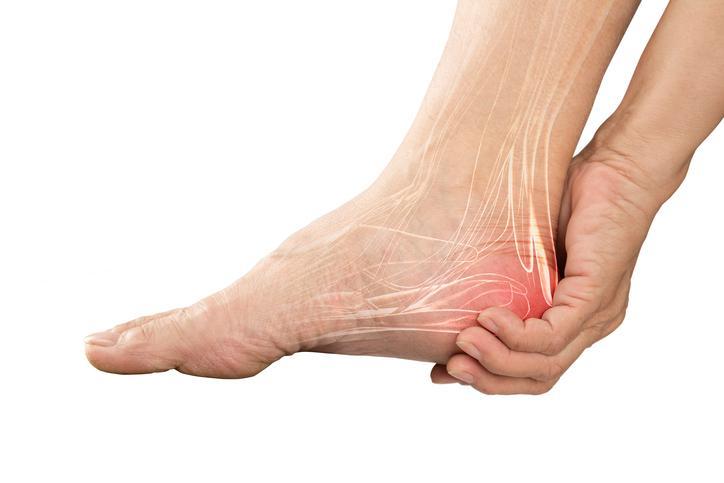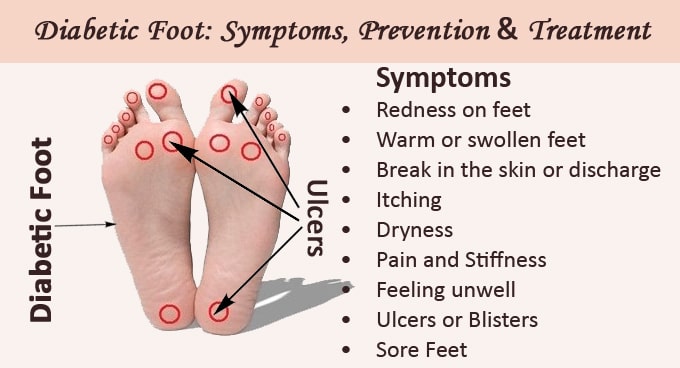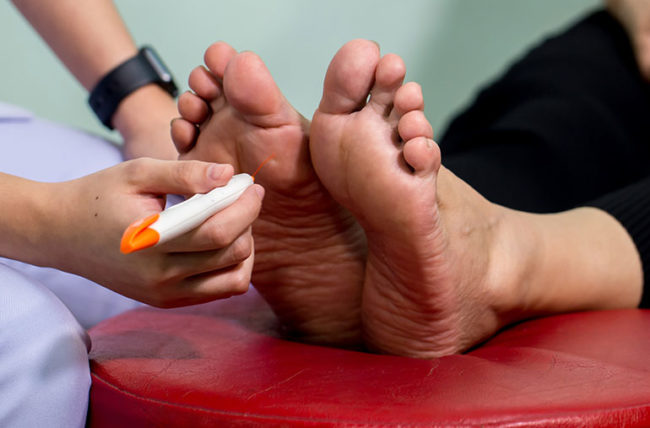DIABETES AND FOOT PAIN
Diabetes leads to damage to feet if you have high blood sugar for a long-term. High blood sugar levels lead to diabetic neuropathy, causing damage to nerves that send signals from your hands and feet.
Diabetes causes faulty, insufficient or low sensitivity to insulin which is an essential hormone responsible for sugar absorption from the blood to use for energy. Due to disturbance in this process sugar remains circulating in the blood, causing health problems.

HOW DOES DIABETES AFFECT HEALTH OF YOUR FOOT?
Diabetes causes damage to your body if sugar level is not managed. There are four types of foot problems arising from poor diabetes management:
1. Nerve problems
Nerve problems such as Peripheral Neuropathy is a major reason for diabetic foot pain. It is a serious diabetic complication where the nerves are directly affected. Feet and legs are affected first, followed by the hands and arms. The symptoms would include:
- Numbness or reduced ability to feel pain
- Temperature changes
- Tingling or burning sensation
- Sharp pains or cramps
- Increased sensitivity to touch — sometimes even a bed sheet’s weight feels painful
- Serious foot problems, such as infections, ulcers and bone and joint pain
There are basically three types of peripheral neuropathy: mono-neuropathy, proximal, and autonomic neuropathy.
Mono-neuropathy or focal neuropathy: It involves damage to a specific nerve resulting in loss of movement, sensation, or other function of that nerve. It is of 2 types cranial and peripheral. Other symptoms include:
- Double vision or Difficulty in focusing
- Pain behind one eye
- Bell’s palsy causing paralysis on one side of your face
- Numbness or tingling in your hand or fingers, except little finger
- Weakness in your hand that may cause weak grip
Proximal neuropathy or diabetic poly-radiculopathy: This mainly affects nerves to the muscles such as thighs, hips, buttocks or legs and abdominal or chest area. Symptoms often start from one side of the body and might spread to the other side of the body. You might experience:
- Severe pain in a hip, thigh or buttock
- Walking imbalances
- Weak and shrinking thigh muscles
- Difficulty getting up from a sitting position
- Severe stomach pain
- Inflammation of the skin
- Increased callus formation
Autonomic Neuropathy: affects the nerves to areas that are not under our conscious control. The sweating mechanism is altered leading to thickened, dry cuticles and nails; as well as dry, stiff, cracked skin — which is subject to a buildup of thick calluses with more pain. Bacterial and fungal infection could be more likely; an additional source of pain and concern.

2. Circulation Problems- They cause intense pain in the feet, even though the feet might feel numb to the touch. The intense pain results from high blood sugars on the arteries, capillaries and veins. Arteries take the fresh blood away from the heart, which nourishes and provides oxygen to the tissues. The arteries behind the knee and the calf are most commonly affected. Arteries suffer from fat deposits that thickens the walls of arteries causing calcium deposits. The fat deposit affects the blood flow to the feet could then be leading them to be partially or totally blocked. These tissues are starving for oxygen, leading to extremely painful conditions described as though the feet are in a vise, and are being strangled. The capillaries get thickened and stiff due to diabetes causing decrease in delivering oxygen and nutrients to and from the tissues. This causes the veins to swell and become painful when the arteries are not capable of handling the blood flow. The little channels are created to direct the blood over to the veins instead of trying to push the blood through closed arteries. Sometimes more blood in the veins makes them full causing them to break causing the blood to pool in the feet and legs. This might leak into the skin, creating ulcerations causing a very painful situation.
3. Muscle & Joint Problems- Diabetic neuropathy, circulation problems and atrophy that affect the muscles. The tendons might become stiff and contract due to the walking imbalance linked with peripheral neuropathy. This forces the foot and joints to move in undesired ways. The tendons might stiffen due to the excess blood sugar combining with the proteins in the joints called as diabetic glycosylation of the joints. These could be a source of pain, infection, ulceration and major medical concern.
4. Frequent Infections- Diabetic people are prone to bacterial, fungal and yeast infections due to medical and nutritional changes taking place in the body. Bacterial infections occur in areas on the foot causing irritation, ulceration or injury. The bacterial infection includes symptoms like redness, swelling, warmth, pain, presence of pus and tenderness. Fungal or yeast infections is a common foot problem occurring as athlete’s feet or fungal toenails. Athlete’s feet lead to skin becoming blistered, scaly, red, inflamed and painful. A bacterial infection might occur along with fungal or yeast infection as the irritated skin is a good place for germs to thrive. Fungal toenails become very thick, powdery and ingrown leaving debris under the nails and cause severe irritation to the skin surrounding the nails. The infection can cause ingrown toes with callused nail grooves.
Not all people suffering from diabetes are able to detect the pain of these problems and therefore foot problems should have their feet visually and manually inspected every day. You should immediately see a doctor if:
- A cut or sore on your foot which is infected and won’t heal
- Tingling, Burning, weakness or pain in your hands or feet interfering with daily activities or sleep
- Changes in digestion, urination or sexual function
- Dizziness and fainting
- diabetes-and-foot-pain

WHAT DOES DIABETES FOOT PAIN FEEL LIKE?
Diabetes-related foot pain include symptoms like:
- Tingling: It feels like a pins and needles kind of sensation.
- Pain or increased sensitivity: It is experienced as pain or sensitivity to normally not painful things. Pain could be caused from bed sheets brushing against your feet or feelings such as socks are uncomfortable or painful to wear.
- Numbness or weakness: Nerves help you feel, and they will tell your muscles to work. Nerve damage causes the legs to feel weak when you stand up.
- Cut and wounds heal slower: Blood vessels carry immune cells that help in wound healing to fight infections and repair the damaged tissue. Poor blood circulation can happen in diabetes that causes long time for wound healing.
HOW CAN I MANAGE DIABETES-RELATED FOOT PAIN?
Diabetes management helps in reducing diabetes-related foot pain. Diabetes cannot be cured but doctors work to prevent it from getting worse. Some tips for prevention of foot pain are:
- Check your feet daily for cuts and wounds
- Wear shoes around house to prevent cuts and injuries
- Follow up with your doctor regularly
- Maintain a healthy diet and exercise routine for lowering high blood sugar
- Stop smoking to reduce the risk of complications
OUTLOOK
The main warning sign for your body is diabetes-related foot pain. Managing your diabetes is the best way to prevent diabetes-related foot pain. High sugar levels are the main cause of nerve pain. Doctors would advise various steps to avoid complications of diabetes by managing your blood sugar levels through diet, exercise, and medications.
If you or anyone you know is suffering from foot problems, our expert providers at Specialty Care Clinics will take care of your health and help you recover.
Call us on (469) 545-9983 to book an appointment with our specialists.
